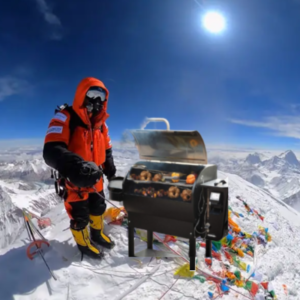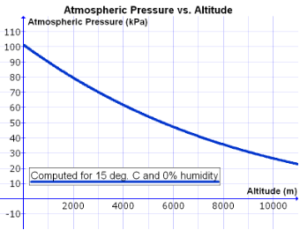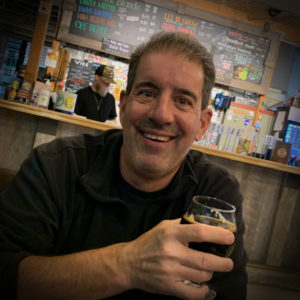
By Gary Robinson,
Cooking Out Loud
Ok…so maybe the picture above is an exageration, we really did not smoke dinner on the top of Everest…but if we did, it would be a challenge, on multiple levels. But cooking of all types at higher altitude is a challenge, especially smoking meat, because it is a lower and slower process.
According to the United States Department of Agriculture (USDA) most cookbooks consider 3,000 feet above sea level to be high altitude, however some recipes may set the elevation differently. You are smoking meat, not baking a cake, so why do you care? Well, you should as it affects many aspects of barbecue or smoking. Let’s dive into some!
Fire Management
 The fire triangle consists of heat, oxygen, and fuel, you must have these three ingredients for fire to ignite. The higher you go in elevation two of the three components of the fire triangle will be affected, heat and oxygen.
The fire triangle consists of heat, oxygen, and fuel, you must have these three ingredients for fire to ignite. The higher you go in elevation two of the three components of the fire triangle will be affected, heat and oxygen.
First let’s look at the heat. As the elevation increases the ambient air temperature will decrease between 3.3- and 5.4-degrees Fahrenheit for every 1,000 feet.
Let’s say that the temperature is 76 degrees in San Diego California (elevation 62 feet above sea level), if you had the same weather conditions in Denver Colorado (elevation 5,280 feet) the temperature could be anywhere from 17 to 28 degrees cooler. A quick and easy calculation to use is multiply the elevation gain times .0033 on cloudy days and .0054 on clear days. Why the difference in equations you ask, when it is cloudy it is like a blanket and traps more heat, so the temperature decrease will more than likely be less on a cloudy day.
ask, when it is cloudy it is like a blanket and traps more heat, so the temperature decrease will more than likely be less on a cloudy day.
Oxygen, an element that is vital to life. Have you ever traveled to a high elevation area such as Denver or the mountains of Colorado and you notice that your breathing may be a little more labored? Myth has it that there is less oxygen as you increase in altitude, however that is not true. The percentage of oxygen (21%) is constant at all altitudes; however, it is 21% of a smaller number as one goes higher. Atmospheric pressure decreases as you gain altitude, the barometric pressure at sea level is 760 mmHg and it decreases approximately 19.6 mmHg for every 1,000 feet above see level.
 So, the barometric pressure in Denver is approximately 102 mmHg lower than San Diego. So, in all actuality the oxygen saturation level changes, it decreases with elevation gain and delivers less oxygen to the body.
So, the barometric pressure in Denver is approximately 102 mmHg lower than San Diego. So, in all actuality the oxygen saturation level changes, it decreases with elevation gain and delivers less oxygen to the body.
I know, you are saying “thanks for the science lesson, but what does this have to do with smoking?”. It has a lot to do with a successful cook, the less heat and oxygen you have the cooler and slower your fire will burn, this will lead to slower cooking and longer cooking times. If you are grilling a hamburger the difference in cooking time will probably be very minimal, if you are smoking an 18-pound brisket the difference can be significant.
Boiling Temperature
Ask anyone at what temperature water boils and it is likely you will get the answer of 212 degrees Fahrenheit. That is a correct answer, if you are at sea level. Now it is time for another science lesson, as the atmospheric pressure decreases (as you rise in elevation), water will boil at a lower temperature.
For every increase of 500 feet in altitude the boiling point decreases by approximately 1 degree. So again, back to the San Diego versus Denver comparison, Water will boil at approximately 212 degrees in San Diego and 202 degrees in Denver.
decreases by approximately 1 degree. So again, back to the San Diego versus Denver comparison, Water will boil at approximately 212 degrees in San Diego and 202 degrees in Denver.
Foods that are prepared by boiling or simmering will cook at a lower temperature at higher elevations, which results in an increased cooking time. Water and other liquids will evaporate faster and boil at lower temperatures.
How does this affect smoking, I am not boiling water! Easy, meat and poultry are composed of muscle, connective tissue, fat, and bone. The muscle is approximately 75% water (this will vary depending on the cut of meat) and 20% protein, with the remaining 5% made up of a combination of fat, carbohydrates, and minerals. The leaner a piece of meat the higher the water content because less fat means more protein which means more water.
Being that meat is comprised of a higher amount of water the boiling point of that water is lower, which means that your meat will cook at a lower temperature and result in slower cooking and longer cooking times.
Humidity
At higher elevations the atmospheric pressure is lower, this results in vapor pressure of water being lower as well. The lower vapor pressure results in less humidity in the air. It is estimated that humidity will decrease at approximately 4% per kilometer (3,281 feet) of elevation gain.
The amount of humidity can have an impact on the cooking times of meat. High humidity levels slow the evaporation of moisture off the surface of the meat, which in turn keeps the surface temperature of the meat high and speeds up the cooking process. Low humidity levels will have the opposite effect, moisture will evaporate quicker and cool the surface of the meat, slowing down the cooking time.
Forget the Science, Let’s talk Smoking!
As you see there is a lot of science involved in the art of smoking meat, it is not just about firing up the smoker and throwing on the meat. There are outside influences that you need to consider to ensure that your cook is successful. When smoking meat, especially at altitude, there are elements that you cannot change, unless you are planning on moving.
You need to understand that fire is going to burn cooler at altitude and take that into account when planning cooking times. Depending on the density and size of the meat it may take up to one-fourth more cooking time. So, what is the answer…crank up the heat? Increasing the cooking temperature will result in water boiling faster which will lead to evaporation and can dry out the meat.
If you want to cook “hot and fast” make sure that you are adding some moisture to the meat. In general, if you are cooking at a higher elevation and in a drier climate, I recommend that you incorporate some sort of moisture into your cooking routine. You can add moisture by spritzing your meat, mopping it, or adding a water pan to your smoker.
Smoking at altitude has its challenges, but they can be easily overcome.
Remember we do things a whole lot differently and better at altitude!
HAPPY SMOKING! 
Gary Robinson-Cooking Out Loud






